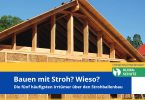In November 2011, a consortium, bringing together the Catholic University of Louvain (Architecture and Climate), the University of Liège (GeMMe and UMC), the Institute for Consulting and Studies in Sustainable Development (ICEDD) and the young company Paille-Tech, is formed around the “aPROpaille” research project funded by the DGO4 (Operational Directorate General for Land Use, Housing, Heritage and Energy) as part of the ERable programme, organised by the Walloon Public Service (DGO4 and DGO6, Operational Directorate General for Economy, Employment and Research). This very comprehensive project made it possible to determine the characteristics and performances of “earth” and “straw” materials, to carry out simulations of the hygrothermal behaviour of straw walls, to compare them with monitoring of existing straw buildings, to carry out a life cycle analysis (LCA) of this type of wall, etc. In addition to the creation of an Internet platform (www.apropaille.be) on the Belgian sector, the main results of this research were gathered at the end of 2015 in three vade-mecums intended for a large and varied public. The aim of these vade-mecums is to provide everyone with rigorous, clear and comprehensible information on recent advances in this field in order to encourage the development of the straw sector used as an insulating material in construction.
FR: En novembre 2011, un consortium, rassemblant l’Université catholique de Louvain (Architecture et Climat), l’Université de Liège (GeMMe et UMC), l’Institut de Conseil et d’Études en Développement Durable (ICEDD) et la jeune entreprise Paille-Tech, est formé autour du projet de recherche « aPROpaille » financé par la DGO4 (Direction générale opérationnelle de l’Aménagement du territoire, du Logement, du Patrimoine et de l’Énergie) dans le cadre du programme ERable, organisé par le Service Public de Wallonie (DGO4 et DGO6, Direction Générale Opérationnelle de l’Économie, de l’Emploi et de la Recherche). Ce projet très complet a permis de déterminer les caractéristiques et performances des matériaux « terre » et « paille », de réaliser des simulations de comportement hygrothermique des parois en paille, de les comparer à des monitorings de bâtiments existants en paille, de réaliser une analyse de cycle de vie (ACV) de ce type de paroi… Outre la réalisation d’une plateforme Internet (www.apropaille.be) sur la filière belge, les principaux résultats de cette recherche ont été rassemblés fin 2015 dans trois vadémécums à destination d’un public large et varié. Ces vadémécums ont pour but d’offrir à tout un chacun une information rigoureuse, claire et compréhensible, des avancées récentes de ce domaine pour favoriser le développement de la filière de la paille utilisée comme matériau isolant dans la construction.
Authors: Evrard, Arnaud; Biot, Benjamin; Keutgen, Gauthier; Lebeau, Frédéric; Courard, Luc; Louis, Arnaud; Bonnert, Antoine







